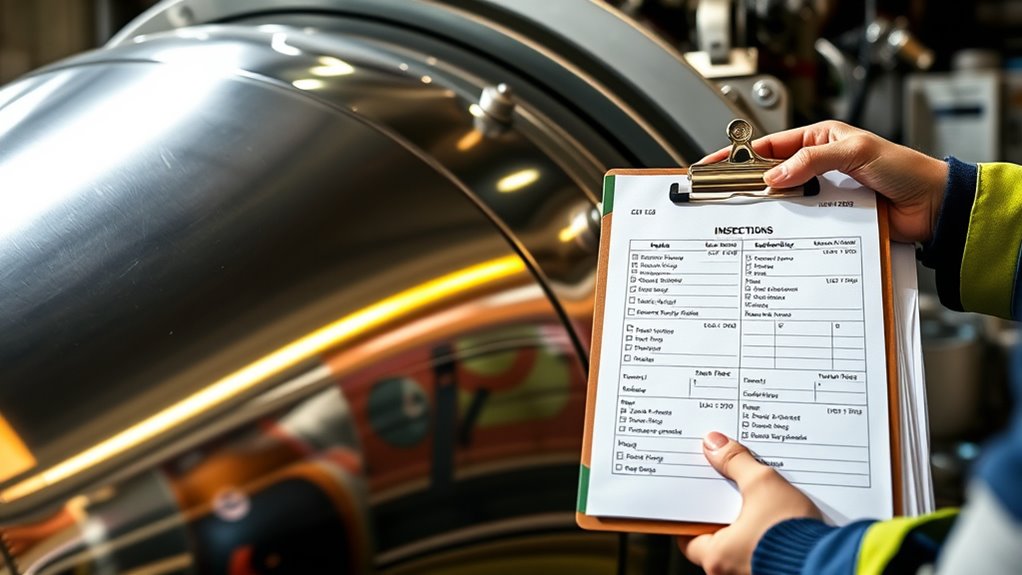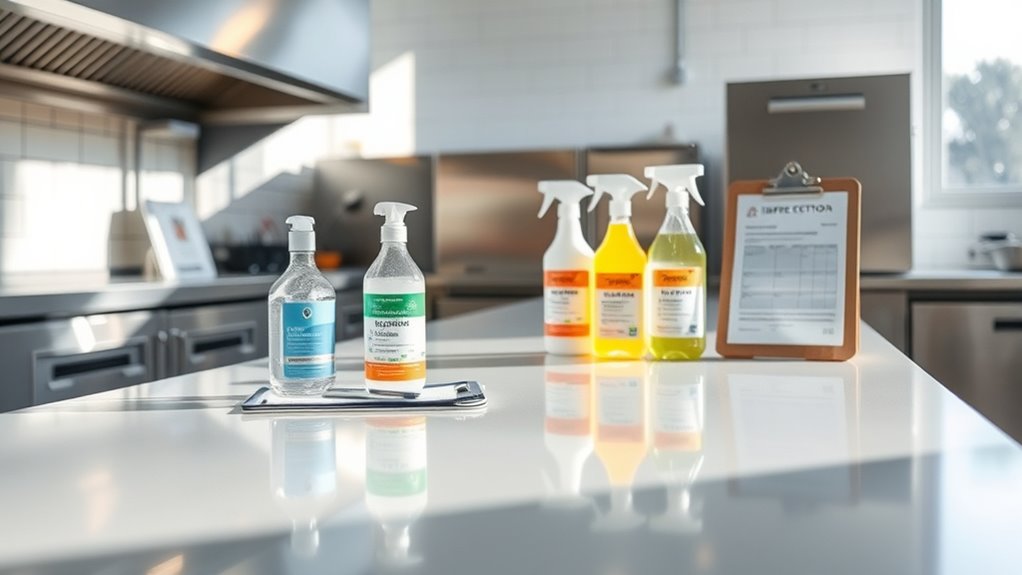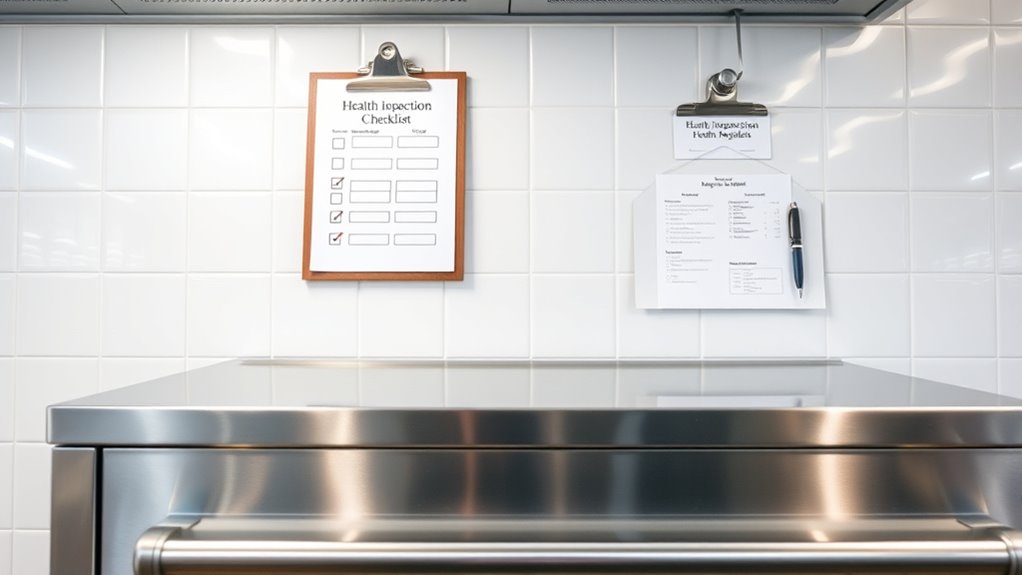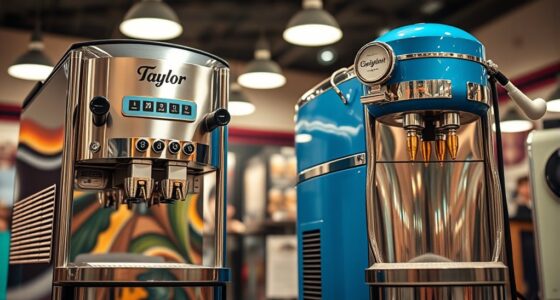To keep your machine inspection-proof before a health check, focus on regular cleaning, sanitizing all surfaces, and maintaining proper temperature controls. Schedule routine preventive maintenance and keep detailed records of repairs and inspections. Train your staff on hygiene and equipment handling, guaranteeing they follow approved cleaning products and procedures. Regularly monitor equipment for issues and ensure professional servicing is up to date. If you want to guarantee a smooth pass, continue on for expert tips to stay prepared.
Key Takeaways
- Schedule regular equipment cleaning, sanitization, and professional maintenance to prevent contamination and ensure compliance.
- Monitor and record temperature controls consistently to keep food at safe levels.
- Train staff on hygiene, proper handwashing, and sanitation protocols to avoid cross-contamination.
- Use approved cleaning products, calibrate equipment regularly, and verify proper functioning with sensors or alerts.
- Keep detailed maintenance and inspection records to demonstrate ongoing compliance and readiness for health inspections.
Conduct Regular Equipment Cleanings and Sanitizations

Regularly cleaning and sanitizing your equipment is essential for maintaining a safe and compliant environment. Establish clear cleaning schedules to ensure each piece of equipment receives proper attention regularly. Consistent routines help prevent buildup of dirt, grease, and bacteria that can lead to health code violations. Use effective sanitization techniques, such as approved sanitizers and proper contact times, to eliminate germs thoroughly. Focus on hard-to-reach areas and frequently touched surfaces to reduce cross-contamination risks. Incorporating proper cleaning techniques and preventative maintenance practices ensures that your equipment remains in top shape and compliant with health regulations. Additionally, scheduling regular inspections can help identify potential issues before they become violations. Implementing routine cleaning protocols helps sustain a hygienic environment and supports ongoing compliance. Document your cleaning schedules and sanitization procedures to demonstrate compliance during inspections. Staying proactive with routine cleaning and sanitizing not only keeps your equipment in top condition but also reinforces your commitment to food safety standards, making health inspections smoother and more successful.
Maintain Proper Temperature Controls for Food Safety

Maintaining proper temperature controls is essential for preventing foodborne illnesses and ensuring compliance with health standards. You should regularly perform temperature monitoring to verify that your equipment keeps foods at safe temperatures. Cold storage units need to stay at or below 40°F (4°C), while hot foods must remain above 140°F (60°C) to prevent bacterial growth. Use calibrated thermometers to check temperatures frequently, especially during busy hours. Proper temperature controls help ensure food safety by reducing the risk of contamination. Monitoring temperature is a critical component of food safety protocols, and staff should be trained to recognize and respond to temperature deviations promptly. Additionally, consistent filter replacement and equipment maintenance contribute to optimal performance and accurate temperature regulation. Staying vigilant with temperature management not only protects your customers but also keeps your operation inspection-proof. Regularly reviewing your food safety procedures can help identify potential issues before they become serious violations. Implementing temperature tracking systems can further enhance accuracy and accountability in your food safety efforts. Proper staff training on cold chain management can further minimize risks associated with temperature mishandling.
Perform Routine Preventive Maintenance Checks

To keep your food safety measures effective, it’s important to routinely check and maintain your equipment. Regular preventive maintenance ensures everything runs smoothly and reduces inspection surprises. Here are four key steps:
- Schedule routine equipment calibration to ensure accurate temperature and performance. Calibration accuracy helps prevent under or overcooking, safeguarding food quality. Additionally, staying informed about local health inspection standards can help you prepare effectively. Incorporating AI-driven monitoring tools can further enhance calibration precision and operational consistency. Knowing how to properly operate and adjust your equipment, such as changing gears on a gravel bike, can also help maintain optimal performance.
- Conduct visual inspections for wear, leaks, or damage that could compromise safety.
- Train staff regularly on proper maintenance procedures and equipment handling.
- Clean and sanitize machines thoroughly to prevent contamination.
- Consider using innovative planters to ensure your food ingredients are stored in clean, safe environments.
Keep Detailed Records of Inspections and Repairs

Keeping detailed records of inspections and repairs is essential for demonstrating your commitment to food safety and ensuring accountability. Effective record keeping involves maintaining thorough inspection documentation that tracks maintenance history, repairs, and routine checks. These records help you quickly identify recurring issues and verify that equipment meets health standards. When health inspectors arrive, well-organized inspection documentation shows you’ve proactively managed your equipment, reducing the risk of violations. Additionally, good record keeping can protect you legally if questions arise about your compliance. Make sure every inspection and repair is documented clearly, with dates, details, and technician notes. Consistent record keeping not only keeps you prepared for health inspections but also helps you maintain a safe and efficient operation. Proper documentation can also serve as a valuable tool in diagnosing ongoing equipment issues, ensuring long-term operational safety. Maintaining organized records further enhances your ability to demonstrate compliance during audits and inspections. Incorporating regular maintenance schedules into your record-keeping processes can further improve your compliance and equipment longevity. Understanding how IRA investments can diversify your portfolio might also inspire you to explore new ways to support your business’s financial stability.
Train Staff on Proper Equipment Handling and Hygiene

Training your staff on proper equipment handling and hygiene is essential for maintaining food safety standards. Well-trained employees follow hygiene protocols and handle equipment correctly, reducing contamination risks. To guarantee effectiveness, focus on these key areas:
- Conduct regular staff training sessions on hygiene protocols and safe equipment use.
- Demonstrate proper handwashing techniques and the importance of personal cleanliness.
- Teach correct procedures for cleaning and sanitizing equipment after each use.
- Reinforce the importance of avoiding cross-contamination through proper utensil and surface handling.
- Incorporate knowledge of natural materials and their impact on hygiene and durability in toy production to emphasize the importance of high-quality, sustainable practices.
- Emphasize the significance of understanding astrological signs and their influence on personality traits to promote team cohesion and customer interactions. Additionally, recognizing recurring patterns in staff behavior and feedback can help address relationship dynamics that affect teamwork and overall hygiene compliance. Recognizing personality traits based on astrological insights can further improve communication and collaboration within the team.
Monitor for Potential Equipment Malfunctions

Regularly monitoring equipment for signs of malfunction is essential to prevent safety hazards and maintain smooth operations. Keep an eye on equipment calibration to ensure machines are functioning accurately and efficiently. If calibration drifts or inconsistent results occur, address them immediately to prevent potential issues. Implement routine malfunction detection checks, such as listening for unusual noises or observing irregular operation patterns. Using sensors or software alerts can help identify problems early. Prompt detection minimizes downtime and reduces the risk of contaminated products. Regular inspections and timely maintenance are key to catching issues before they escalate. Staying vigilant helps you maintain compliance and ensures your equipment operates safely, protecting both your staff and consumers. Alimony laws can influence how equipment is maintained and monitored in certain contexts, emphasizing the importance of legal awareness in operational protocols.
Use Approved Cleaning and Sanitizing Products

Using only approved cleaning and sanitizing products is essential to guarantee safety and compliance in your facility. These products ensure your cleaning schedules and sanitizing protocols meet health standards. To stay inspection-ready, focus on:
- Verifying that all cleaning supplies are certified for food contact surfaces.
- Following manufacturer instructions precisely for each product’s application.
- Regularly updating your cleaning schedules to include approved sanitizers.
- Training staff on proper use to prevent cross-contamination.
Sticking to approved products not only maintains hygiene but also demonstrates your commitment to safety during inspections. Proper sanitizing protocols build trust with inspectors and protect your customers. Keep your equipment inspection-proof by adhering strictly to these guidelines.
Schedule Professional Servicing Before Inspections

Scheduling professional servicing before your health inspection guarantees all equipment is thoroughly checked and functioning properly. Expert maintenance catches potential issues early, saving you time and costly repairs later. Regular preventive service keeps your facility compliant and ready for inspection at any time.
Expert Maintenance Checks
To guarantee your establishment passes health inspections with flying colors, booking a professional maintenance check before the inspection is essential. During this check, experts focus on critical areas like equipment calibration, ensuring machines operate accurately and safely. They also assess staff training to verify proper handling and hygiene protocols. To maximize your readiness, consider these steps:
- Confirm all equipment is calibrated according to standards.
- Ensure staff demonstrate proper cleaning and sanitation techniques.
- Check for any signs of wear or malfunction on appliances.
- Request detailed reports to address issues before inspection day.
These proactive measures help catch problems early, streamline your inspection process, and build confidence that your establishment meets health standards.
Preventive Service Benefits
Have you considered how preventive service can streamline your health inspections? Regular professional servicing ensures your equipment is up-to-date with necessary upgrades, reducing the risk of violations. Equipment upgrades during preventive maintenance can enhance performance, minimizing downtime and repair costs. This proactive approach also boosts energy efficiency, helping you pass inspections more easily and lower operational expenses. By scheduling routine service, you catch potential issues early, avoiding last-minute surprises that could delay approval. Additionally, well-maintained equipment demonstrates your commitment to safety and compliance, impressing inspectors. Preventive service isn’t just about avoiding penalties; it’s about optimizing your operations for safety, efficiency, and peace of mind. Staying ahead with scheduled professional servicing keeps your machinery inspection-proof and your business running smoothly.
Frequently Asked Questions
How Often Should Equipment Be Sanitized for Optimal Inspection Readiness?
You should follow your sanitation schedules and inspection checklists to determine how often equipment needs cleaning. Regular sanitation, ideally daily or after each shift, helps keep equipment inspection-ready and prevents contamination. Incorporate routine checks into your procedures, ensuring cleanliness standards are consistently met. By staying proactive with sanitation schedules and inspection checklists, you’ll maintain equipment that passes inspections with ease and keeps your operation running smoothly.
What Are the Best Practices for Documenting Maintenance Activities?
To keep your machines inspection-proof, you should diligently document maintenance activities using detailed maintenance logs. Always update these logs immediately after maintenance tasks, noting the date, technician, and specific work performed. Use inspection checklists to ensure all steps are completed and verified. Regularly review and organize your records so they’re easy to access during inspections. This proactive approach demonstrates your commitment to compliance and helps avoid potential issues.
How Can Staff Be Effectively Trained on Hygiene Standards?
You should focus on staff training to guarantee hygiene compliance. Start with clear, hands-on sessions that emphasize proper handwashing, sanitizing, and personal hygiene. Use visual aids and practical demonstrations to reinforce standards. Regularly refresh training and provide feedback, so your team stays confident and consistent. Encourage questions and create a culture where hygiene is a top priority. Well-trained staff naturally uphold hygiene standards, making inspections smoother and your environment safer.
What Signs Indicate Equipment Is Malfunctioning Before Inspection?
You should watch for signs of equipment malfunction, such as unusual noises, inconsistent temperatures, or leaks, which are clear inspection signals of issues. Regularly check gauges and indicator lights, and listen for strange sounds during operation. If you notice any of these signs, address them promptly to prevent inspection problems. Maintaining equipment and recognizing malfunction indicators help guarantee smooth operation and compliance during inspections.
Which Cleaning Products Are Safest and Most Effective for Food Equipment?
When choosing cleaning products for your food equipment, prioritize chemical safety and eco-friendly cleaners to guarantee safety and effectiveness. Look for products labeled as food-safe and free from harsh chemicals. Eco-friendly cleaners typically use natural ingredients, reducing health risks and environmental impact. Always follow manufacturer instructions for proper use, and regularly inspect equipment to prevent buildup or damage. This approach keeps your machine clean, safe, and inspection-ready.
Conclusion
By staying vigilant and nurturing your equipment like a well-tended garden, you’ll guarantee it remains inspection-proof. Regular cleaning, diligent maintenance, and proper training act as your shield against surprise inspections. Think of your machine as the heartbeat of your operation—keep it steady, clean, and responsive. When you proactively care for your equipment, you’re not just passing inspections; you’re orchestrating a symphony of safety and excellence that leaves a lasting impression.









